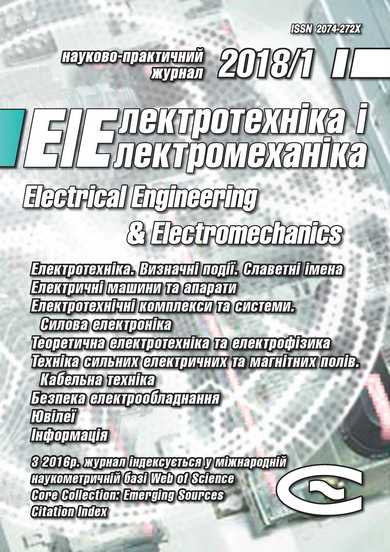EXPERIMENTAL SUBSTANTIATION OF THE CALCULATION PROCEDURE OF NORMALIZED PARAMETERS OF GROUNDING DEVICE BASED ON THE THREE-LAYER SOIL MODEL
DOI:
https://doi.org/10.20998/2074-272X.2018.1.11Keywords:
grounding device, resistance, touch voltage, three-layer soil modelAbstract
Purpose. Experimental substantiation of the possibility of using the calculation procedure of normalized parameters grounding devices on the basis of a three-layer model soil. Methodology. The research was based on comparison of the results of experimental measurements for the existing high voltage energy facilities of Ukraine with the results of the calculation. Results. Comparison showed that the average error decreased from 18 % for the two-layer model to 10 % for the three-layer model. The analysis of the calculated and experimentally determined values of the touch voltage showed a high degree of coincidence. Originality. The adequacy of the calculation procedure of the normalized parameters of the grounding device for model with three-layer soil is substantiated by the results of experimental research on the existing energy objects. Practical value. The obtained results allow us to use calculation procedure to create software to determine with increased accuracy the normalized parameters of grounding device located in three-layer soils.
References
1. IEEE Standard 81-2012. IEEE Guide for measuring Earth resistivity, ground impedance, and Earth surface potentials of a grounding system. [Amended by 2012-12-28]. New York: IEEE, 2012. 86 p. doi: 10.1109/ieeestd.2012.6392181.
2. Natsional'nyy standart Ukrayiny. SOU 31.2-21677681-19:2009. Viprobuvannya ta kontrol' prystroyiv zazemlennya elektroustanovok. Tipova іnstruktsіya. [National Standard of Ukraine SOU 31.2-21677681-19:2009. Test and control devices, electrical grounding. Standard instruction]. Kyiv, Mіnenergovugіllya Ukrayiny Publ., 2010. 54 p. (Ukr).
3. Tabatabaei N.M., Mortezaeei S.R. Design of grounding systems in substations by ETAP intelligent software. International Journal on «Technical and Physical Problems of Engineering» (IJTPE), 2010, iss.2, vol.2, no.1, pp. 45-49.
4. Turri R., Andolfato R., Cuccarollo D. A numerical simulation tool for cathodic protection and electromagnetic interference analysis. NACE Milano Italia Section – Conference & Expo 2016 «A European event for the Corrosion Prevention of Oil&Gas industry». 17 p. Available at: https://www.researchgate.net/publication/303685228_A_NUMERICAL_SIMULATION_TOOL_FOR_CATHODIC_PROTECTION_AND_ELECTROMAGNETIC_INTERFERENCE_ANALYSIS (accessed 22 September 2016).
5. Zubov K.N. Sovershenstvovanie raschetnykh metodov molniezashchity i zazemliaiushchikh ustroistv v neodnorodnykh gruntakh. Diss. cand. techn. nauk [Improved computational methods for lightning protection and grounding devices in heterogeneous soil. Cand. tech. sci. diss.]. Vologda, 2011. 158 p. (Rus).
6. Koliushko D.G. Sovershenstvovanie diagnostiki zazemliaiushchikh ustroistv elektroenergoob"ektov. Diss. cand. techn. nauk [Improving the diagnosis of grounding devices for electric power objects. Cand. tech. sci. diss.]. Kharkov, 2003. 172 p. (Rus).
7. Unde M.G., Kushare B.E. Grounding grid performance of substation in two layer soil – a parametric analysis. International Journal of Engineering Sciences & Emerging Technologies, 2012, vol.1, no.2, pp. 69-76. doi: 10.7323/ijeset/v1_i2_8.
8. Koliushko D.G., Rudenko S.S., Koliushko G.M. Analysis of electrophysical characteristics of grounds in the vicinity electrical substation of Ukraine. Electrical engineering & electromechanics, 2015, no.3, pp. 67-72. (Rus). doi: 10.20998/2074-272X.2015.3.10.
9. Koliushko D.G., Rudenko S.S. Mathematical model of grounding connection of a power plant with under layer. Electronic modeling, 2014, vol.36, no.2, pp. 89-97. (Rus).
10. International Organization for Standardization. ISO 5725-2: 1994: Accuracy (Trueness and Precision) of Measurement Methods and Results-Part 2: Methods for the Determination of Repeatability and Reproductibility. International Organization for Standardization, 1994.
Downloads
Published
How to Cite
Issue
Section
License
Copyright (c) 2018 D. G. Koliushko, S. S. Rudenko

This work is licensed under a Creative Commons Attribution-NonCommercial 4.0 International License.
Authors who publish with this journal agree to the following terms:
1. Authors retain copyright and grant the journal right of first publication with the work simultaneously licensed under a Creative Commons Attribution License that allows others to share the work with an acknowledgement of the work's authorship and initial publication in this journal.
2. Authors are able to enter into separate, additional contractual arrangements for the non-exclusive distribution of the journal's published version of the work (e.g., post it to an institutional repository or publish it in a book), with an acknowledgement of its initial publication in this journal.
3. Authors are permitted and encouraged to post their work online (e.g., in institutional repositories or on their website) prior to and during the submission process, as it can lead to productive exchanges, as well as earlier and greater citation of published work.





